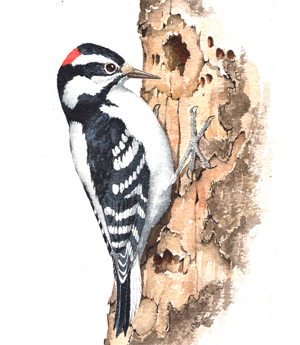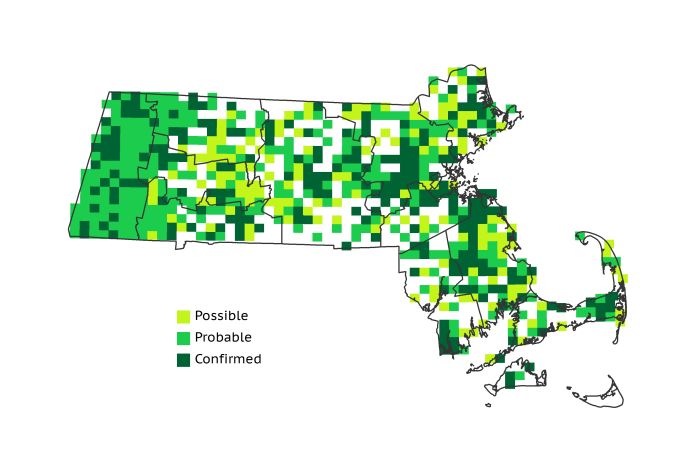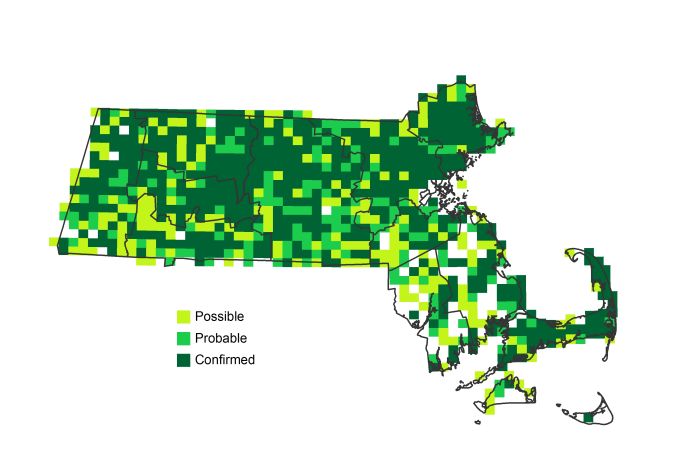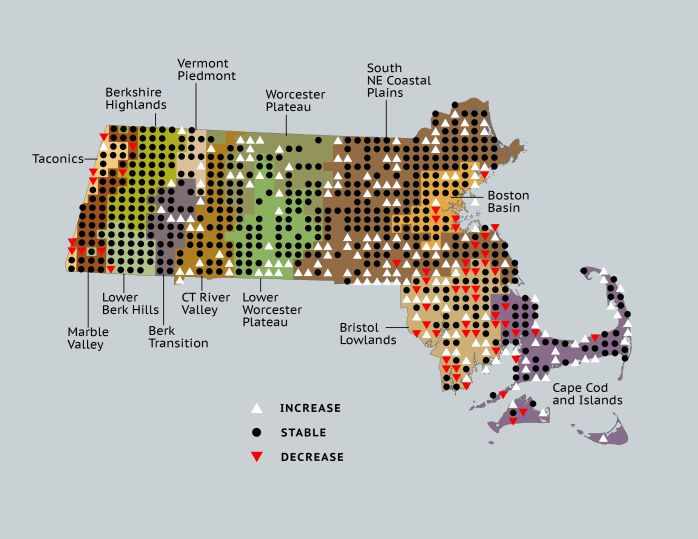Find a Bird
Hairy Woodpecker
Picoides villosus

Nearly ubiquitous and likely increasing
“It was very wild, running on the trunks and limbs of trees with the agility peculiar to the family, always contriving to keep on the side of the trunk most distant from its pursuer.” – Dr. James Trudeau, Journal of the Academy of Natural Sciences of Philadelphia, Vol. VII
The bristly, hair-like feathers on the backs of Hairy Woodpeckers give them and Downy Woodpeckers their common names. The origin of these names comes from the fact that both species were first described from dead specimens. In the hand, it is quite clear that the vertical stripe of white feathers on a Downy Woodpecker’s back is soft and smooth while the feathers on a Hairy Woodpecker’s back are longer and shaggier. In the field, these otherwise similar species are better distinguished by voice, size, and other plumage characters. Like Downy Woodpeckers, Hairy Woodpeckers are becoming more widespread in Massachusetts.
Historic Status
The Hairy Woodpecker is a bird that has simply always seemed to be around in the woods and forests. A state report in 1839 described it as “a pretty bird, which comes so familiarly near our houses, that everyone has seen it, intent upon its labor, searching for grubs and insects, not only in trees, but in posts, rails, and all kinds of decaying wood.” (Peabody 1839). Their primary enemy was likely deforestation. In the early part of the twentieth century, Forbush noted that in winter they moved from their northern and western forested breeding grounds into orchards and gardens, and even into the denuded southeastern Massachusetts where they were particularly absent in summer (Forbush 1927). As forests have changed in the state, Hairy Woodpecker numbers have fluctuated accordingly.
Atlas 1 Distribution
Hairy Woodpeckers weren’t difficult to find in most parts of the state during Atlas 1, but their stronghold was the western parts of the state. The Taconic Mountains, Marble Valleys, Lower Berkshire Hills, and Berkshire Highlands had Hairys in 94% or more of their blocks. The birds were less widespread through the Berkshire Transition and in the Connecticut River Valley, especially at its wide southern end. The Worcester and Lower Worcester Plateaus set the tone for distribution in most of the rest of the state with Hairy Woodpeckers in more than half of their blocks. This trend held for all eastern ecoregions save the Cape and Islands, where the birds were scarcer, and Nantucket had no Hairy Woodpeckers at all.
Atlas 2 Distribution and Change
In the western part of the state, Hairy Woodpecker distribution in Massachusetts did not change much between Atlas 1 and Atlas 2. Small declines in saturated regions like the Taconic Mountains and Lower Berkshire Hills were as likely the result of random fluctuations as indications of an actual decline. The Connecticut River Valley and Worcester Plateau regions showed marked increases in occupancy since Atlas 1. Hairy Woodpecker numbers appeared to be on the rise across much of eastern Massachusetts as well, even in the Boston Basin. The Bristol/Narragansett Lowlands remained overall stable amidst other increasing regions, but showed considerable shuffling among blocks.
Atlas 1 Map

Atlas 2 Map

Atlas Change Map

Ecoregion Data
Atlas 1 | Atlas 2 | Change | ||||||
Ecoregion | # Blocks | % Blocks | % of Range | # Blocks | % Blocks | % of Range | Change in # Blocks | Change in % Blocks |
Taconic Mountains | 15 | 93.8 | 2.3 | 18 | 72.0 | 2.1 | -3 | -20.0 |
Marble Valleys/Housatonic Valley | 39 | 100.0 | 6.1 | 35 | 89.7 | 4.1 | -4 | -10.3 |
Berkshire Highlands | 52 | 94.5 | 8.1 | 54 | 98.2 | 6.3 | 1 | 1.9 |
Lower Berkshire Hills | 28 | 100.0 | 4.3 | 28 | 90.3 | 3.2 | -1 | -3.7 |
Vermont Piedmont | 12 | 70.6 | 1.9 | 17 | 100.0 | 2.0 | 2 | 16.7 |
Berkshire Transition | 30 | 78.9 | 4.7 | 39 | 97.5 | 4.5 | 5 | 16.1 |
Connecticut River Valley | 41 | 73.2 | 6.4 | 59 | 90.8 | 6.8 | 10 | 20.8 |
Worcester Plateau | 46 | 59.0 | 7.1 | 86 | 97.7 | 10.0 | 15 | 31.3 |
Lower Worcester Plateau | 53 | 71.6 | 8.2 | 77 | 96.3 | 8.9 | 9 | 16.7 |
S. New England Coastal Plains and Hills | 169 | 62.6 | 26.2 | 259 | 91.5 | 30.0 | 58 | 25.7 |
Boston Basin | 33 | 58.9 | 5.1 | 38 | 67.9 | 4.4 | 5 | 9.1 |
Bristol and Narragansett Lowlands | 67 | 63.2 | 10.4 | 69 | 60.5 | 8.0 | 0 | 0.0 |
Cape Cod and Islands | 59 | 43.4 | 9.2 | 85 | 59.0 | 9.8 | 18 | 15.0 |
Statewide Total | 644 | 66.5 | 100.0 | 864 | 83.3 | 100.0 | 115 | 13.9 |
Notes
The Hairy Woodpecker shows a significant increasing Breeding Bird Survey trend in the Eastern US overall.



